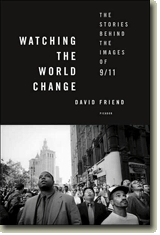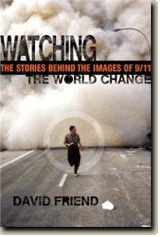March 2009 Archives
« Previous · Home · Next »
March 29, 2009
FAIREY & FAIR USE
FAIR USE? When is an artist’s appropriation of a journalistic photograph considered an “homage” and when is it just plain old-fashioned theft?
A recent piece in The New York Times by Noam Cohen explores a subject that has been in the art and journalism press a lot lately: the motives behind artist Shepard Fairey’s wholsesale “borrowing” of an Obama headshot - by AP’s Mannie Garcia – for Fairey’s famous Obama HOPE poster.
Fairey’s work is now on view, through August, at Boston’s Institute of Contemporary Art.
CLICK!... A while back photography impresario Marvin Heiferman was kind enough to ask me to participate in the Smithsonian Institution’s photographic initiative “click! photography changes everything.” I complied and wrote a piece that borrowed from two sections of Watching the World Change concerning the September 2001 project, "2001," by the new-media artist Wolfgang Staehle.
This week, the Smithsonian invited the public to submit its own photographs and written responses to create a user-generated dialogue on how photography influences society. So... click on over to "click!"
…BY THE WAY… The reviews are coming in and the verdict is thumbs-up for Claire Castillon’s new book, My Mother Never Dies (Houghton Miflin) translated from the French.

…AND FINALLY… On VanityFair.com I try to clarify Obama Stimulus Package #17.
March 14, 2009
PHOTO SYNTHESIS
PHOTOCHAINING. Now, this is an inspired idea: a chain-letter-style photo blog, called Photochaining.com, in which a stranger leaves a photo memory card in a public place so that a passerby finds it, adds his or her pictures, uploads images to the card and blog and, in turn, leaves the card in yet another (preferably distant) place for someone else to discover.
It’s the digital-age equivalent of the old message-in-a-bottle tossed into the ocean.
PHOTO SYNTHESIS. And if you’re looking for a perceptive, random, personal, acutely attuned visual survey of current art photography, books, exhibitions, projects, check out Doug McGoldrick’s smart site, Adjustment Layer. Always eye-opening.
March 1, 2009
MARCH MARCHES IN
ROCKY DESCENT. Alas. After 150 years, The Rocky Mountain News is no more. Under the leadership of Janet Reeves, the Rocky’s crack photography department produced years of memorable, award-winning coverage. Their consistent dedication and impact proved, once again, that quality photojournalism takes quality people.
Yet another paper, integral to the collective consciousness of its community, will be sorely missed. Below: the final front page.

OLD IMAGES MADE NEW. My friend Ed Grazda, the photographer, writer, and publisher, came by with the newest offerings from Errata Editions. Errata, as exemplified in its stunning set of four new volumes, reproduces classic or long-neglected out-of-print photography books for the academic and collectors' markets. I urge readers to sample Walker Evans: American Photographs (below) along with the other new titles from Errata.

…And, while we’re at it: Umbrage is offering an exhibition (opening March 5) and new book, Eddie Adams: Vietnam, showcasing the wartime images of the late Eddie Adams, an outsize figure in the picture business who founded the influential annual Eddie Adams Workshops at his farm in upstate New York.

COMING HOME. At last. One small click for truth. The Obama administration has instructed the Pentagon to relax its ban on photography of the coffins of American combatants arriving back in the U.S. from the battlefield, an edict that dates back to the 1991 Gulf War. And I have to believe that with little fanfare this president and first lady will even attend a funeral or two, unlike their predecessors.
HALF-LIFE. Ever-spot-on Virginia Heffernan, writing in today’s New York Times Magazine, correctly criticizes the way Google seems to have dumped the Life photo archive online. She cites the unimaginative organization, short-shrift captions, generally lackluster design, and laborious navigation. She fails to mention how uneven the scans are. Many look like they were deliberately copied in a flat grey-scale with little contrast. Low resolution (to avoid pilfering), I can understand. But many of the scans appear to have been done rather carelessly.
VANITY PRESS. By the way, I posted two pieces on VanityFair.com this week that might be of interest: a review of Jazz at Lincoln Center’s 70th anniversary tribute to Blue Note Records…and a satire on Condi Rice’s new childrens’ book titles, which got some play on Publishers Weekly's Website.

Illustration for VanityFair.com by Julian Sancton.
LAST BUZZ. In closing, I wanted to pass along a gem from Jeff Jarvis, the dynamo behind BuzzMachine.com and a colleague of mine at both Time Inc. and Conde Nast. (It was Professor Jarvis who taught me how to blog. So all this is all his fault, I guess.)
In Jarvis’s engaging new book, What Would Google Do?, he lists the often counterintuitive dicta that now govern the Net. Among the most eye-opening:
“Owning pipelines, people, products, or even intellectual property is no longer the key to success. Openness is.”



